Year of Resilience
How the Lumberjack community adapted and thrived during a year like no other
By Nora Mounce
LAST FALL, junior Gracie Oliva found herself gazing at the redwood canopy from a twisty trail deep within Arcata's Community Forest. A Recreation Administration major, Oliva and a small knot of students were hiking as part of Professor Geneviève Marchand's face-to-face Outdoor Adventure Recreation course. As the class took a physically distanced break, Marchand asked her students to pause and take it all in. After a few moments of silence, the class began to reflect on the toll of the COVID-19 pandemic and their opportunity, as students, to create pathways to a healthier future.
"'How can we be better as a community? To ourselves? To our marginalized peers? To the land?'" Oliva recalls asking herself. She says that Fall semester 2020 was her best semester at HSU yet, despite the impacts of COVID-19.
At HSU, 25% of courses have a hands-on component (labs and field-based activities, for example), which is among the highest in the 23-campus California State University system. Because of this, HSU was granted permission to offer half of those courses with a modified face-to-face model last Fall.
Faculty like Marchand followed strict safety protocols developed by the state, county, and CSU, including testing, face coverings, distancing, quarantining, and compliance, in order to make experiential learning a reality.
"Learning by doing is a key element of our educational approach," says HSU President Tom Jackson, Jr. "At the same time, we've worked hard to elevate learning in virtual courses and expand student support across the University."
For students like Oliva, it has made all the difference. "Whether virtual or face-to-face, each class was still consistently rooted in our personal program," she says. Like many of her peers, Oliva praised faculty for their sensitivity and inclusion over the past year, and for going above and beyond to support students facing unknown challenges during the pandemic.
"I will always cherish that memory of my class in the redwood forest as a reminder of how good it feels to be part of something bigger than myself," says Oliva.
One student's reflection captures the determination and teamwork that took place across the University in the past year of uncertainty. Working together to overhaul operations, launch robust virtual curriculum, ensure hands-on learning, and boost morale, a spirit of unity continues at Humboldt State.
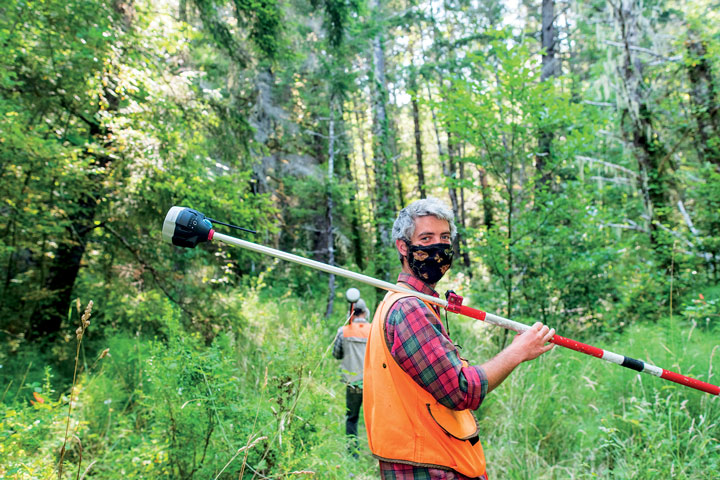
A student does research on California's diverse forest types at the L.W. Schatz Demonstration Tree Farm.
"We've seen faculty embracing new technology while being intellectually playful and working to move students forward. It's been amazing to see what instructors are discovering about themselves and their students."
Enoch Hale, director,
Center for Teaching & Learning
Faculty Dig Deep
When asked to learn new things, work differently than ever before, and above all, come together for students, HSU faculty said “yes.” They spent extra time last summer preparing for virtual classes and modified face-to-face instruction.
Assisted by the Center for Teaching & Learning (CTL), faculty redesigned syllabi, labs, homework, performances, and exams, all with students’ success and wellbeing in mind.
“Rather than replacing in-person interactions with technology, we help instructors use tools that humanize learning,” explains CTL Director Enoch Hale.
Often, this starts with improving accessibility for remote learning, such as user-friendly “liquid syllabi,” which students can access with one click on any mobile device. It also means infusing course content with videos, games, and opportunities to interact with instructors and peers that model the in-person classroom experience.
Dynamic virtual instruction depends on flexible approaches to teaching and learning, explains Hale. While many teaching tools have translated seamlessly to virtual platforms, the shift has forced educators to reevaluate pedagogies and ask themselves how they can best share their knowledge.
“We’ve seen faculty embracing new technology while being intellectually playful and working to move students forward,” says Hale. “It’s been amazing to see what instructors are discovering about themselves and their students.”
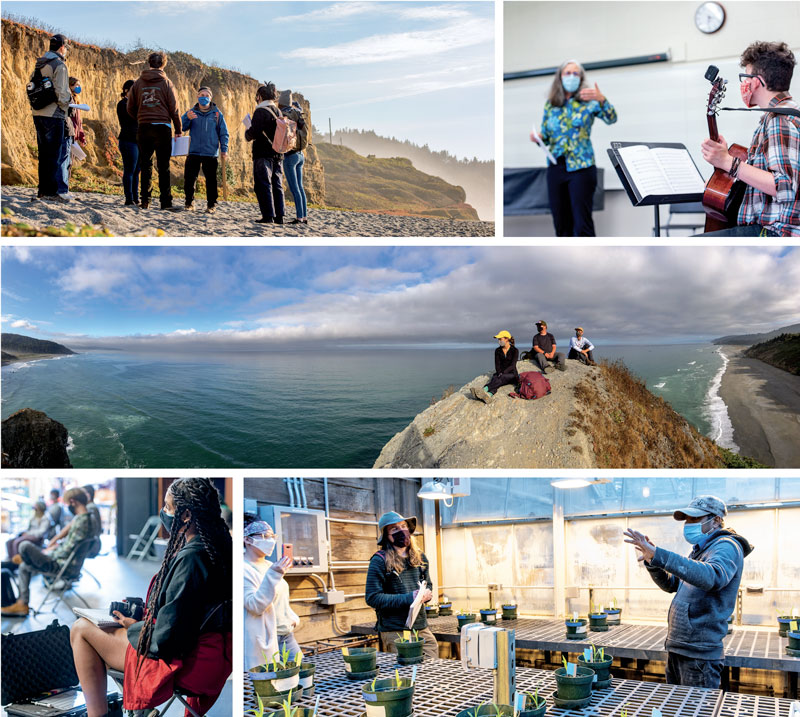
Top Left: Geology students during a field trip with Professor Mark Hemphill-Haley at Big Lagoon State Park. Top Right: A student practices chamber music in the Guitar Lab with instructor Jennifer Trowbridge. Middle: Recreation Administration students take it all in during Professor Geneviève Marchand’s face-to-face Outdoor Adventure Recreation course. Bottom Left: Students learn about camera settings in Film 315. Bottom Right: Forestry instructor Buddhika Madurapperuma works with students in the Forestry and Range Experimental Greenhouse during a sustainable agriculture course.
Staying Connected
With adherence to strict safety protocols, Outdoor Adventure Recreation was deemed safe and essential for face-to-face instruction last Fall. But in any semester, the success of Marchand’s course depends on students’ teamwork, a valuable lesson in developing outdoor leadership skills.
“The adventure education world is very group-oriented,” says Professor Marchand. “A huge element is learning to work in groups in challenging settings.”
In normal semesters, students work together on technical skills like setting up shelter and reading maps for Marchand’s backpacking class. During the pandemic, they’ve still gone backpacking, but preparations are largely individual to maintain social distance.
Marchand, who prides herself on strong student connections, says that the smaller group outings have actually made those relationships even stronger. And while tasks like cooking on a backpacking stove are more difficult alone, students are learning self-reliance, a critical skill in the outdoor recreation industry.
“I know the pandemic has been hard on them, but these semesters have been just as valuable as any other,” says Marchand.
Art instructor Jimmie Nord also found a silver lining in making stronger connections with individual and small groups of students.
“Art is a wonderful way to get to know someone,” says Nord. “I’ve really seen my students dig deep and get creative during the pandemic.”
Without any experience in online teaching, Nord was unsure what to expect after the pivot to virtual instruction last Spring. But overall, he has found that simple modifications to his approach have led to successful outcomes.
In “Stories We Tell,” a module that Nord co-teaches with Music Professor Elisabeth Harrington and Film instructor Michelle Cartier, Nord helps freshmen learn college skills while using creative media. In Nord’s portion of the course, students used found objects from their homes to create a self-portrait sculpture.
Instead of gathering for a final critique, the class watched together on Zoom, with Harrington playing her students’ compositions live on the piano. “It felt like a film festival,” says Nord. “It was pretty cool!”
In typical semesters, Nord provides all the supplies for his art students. Since last Spring, he has helped his students find creative workarounds by using materials they already had at home. In the process, Nord says that his students’ critical thinking and problem solving skills have blossomed.
“Many of them had never made a sculpture before,” says Nord. “It was cool to see students come up with their own ideas, using gravity and balance, to make art.”
It has been a lesson in adaptation for Nord as well. He learned that less time-intensive assignments allow students more opportunity to connect with him and their peers while reducing the temptation to procrastinate.
“I think they’re working harder because they know how much I care,” says Nord.
Wildlife Professor Daniel Barton made the most of his graduate students being displaced by the pandemic last Fall. To mimic in-person learning through online instruction, Barton designed a distributed experiment in which students individually collected data to later populate into a larger dataset. Using AudioMoths, a low-cost acoustic monitoring device, each graduate student collected recordings of nocturnal bat activity. In preparation for the activity, Barton shipped and distributed supplies himself, including AudioMoths, batteries, and zip ties.
“Each student recorded bat vocalizations in their backyard or a local greenspace, as long as COVID-19 safety regulations allowed,” explains Barton. In the process, students learned how to set up and configure an AudioMoth and compile data that tracked wildlife abundance and occurrence.
“Some things went wrong, some things went right,” says Barton. “That’s why we do experiments.”
Barton’s approach to remote learning and fieldwork was informed by his own research into the topic with an article, “Impacts of the COVID-19 Pandemic on Field Instruction and Remote Teaching Alternatives,” recently published in the journal “Ecology and Evolution.” After surveying faculty from around the country, Barton compiled instructors’ experiences and pitfalls with online teaching for natural science disciplines traditionally taught in the field.
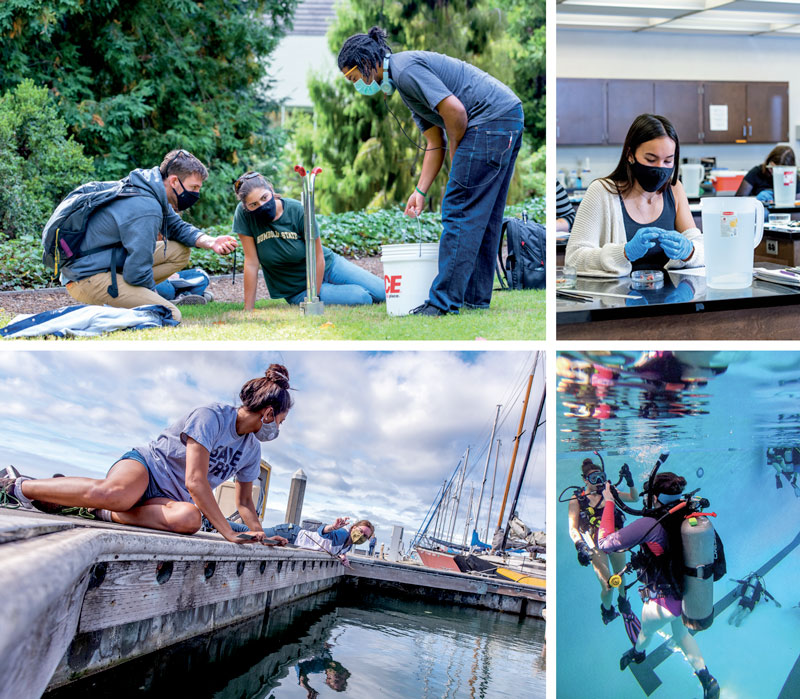
Top Left: An Environmental Resources Engineering hydrology lab takes place outside on campus. Top Right: Oceanography students work at lab stations to record phytoplankton sinking rate measurements. Bottom Left: Biology students try to count the number of organisms at the Eureka Marina. Bottom: Right Recreation Administration students start training to become Master Scuba Divers in the pool before diving into open water.
Campus Reimagined
While virtual learning continues to take place wherever HSU students call home, hundreds of essential workers are busy keeping campus safe and operational back in Arcata.
Playing a pivotal role in the University’s pandemic response, the Emergency Operations Center (EOC) has worked to stay ahead of public health recommendations and best practices in higher education. The EOC and various advisory groups have continued to meet biweekly throughout the pandemic to plan, prepare, and respond to the virus’ effect on every aspect of campus.
“Given everything that we’re facing, communication has been the single throughline,” says Mike Fisher, interim associate vice president for Facilities Management.
Dozens of staff members from every campus division convened in 2020 to activate the EOC, which trains regularly and provides a leadership structure to crisis response.
With the guidance of Cris Jones Koczera, EOC coordinator and interim director of Risk Management & Safety Services, Facilities Management reimagined campus last Spring, reducing classroom occupancy by removing furniture, posting directional signage, and installing controls like plexiglass shields and air-filtration systems. On average, instructional rooms are now being used at 30% of their original occupancy.
Early in the pandemic, the University purchased electrostatic sprayers, which custodians use to disinfect rooms after use. Custodial staff also regularly restocks classrooms with wipes and hand sanitizer. Looking toward Fall ‘21, campus custodians will continue to be essential in HSU’s containment strategy against the virus.
“Rolling out a coordinated and effective response to an unprecedented emergency has been a tremendous workload for our staff and faculty,” says Koczera. “But watching departments and individuals work together, all for the safety and protection of our students, has been inspirational.”
"Rolling out a coordinated and effective response to an unprecedented emergency has been a tremendous workload for our staff and faculty. But watching departments and individuals work together, all for the safety and protection of our students, has been inspirational."
Cris Jones Koczera, EOC coordinator and interim director of Risk Management & Safety Services
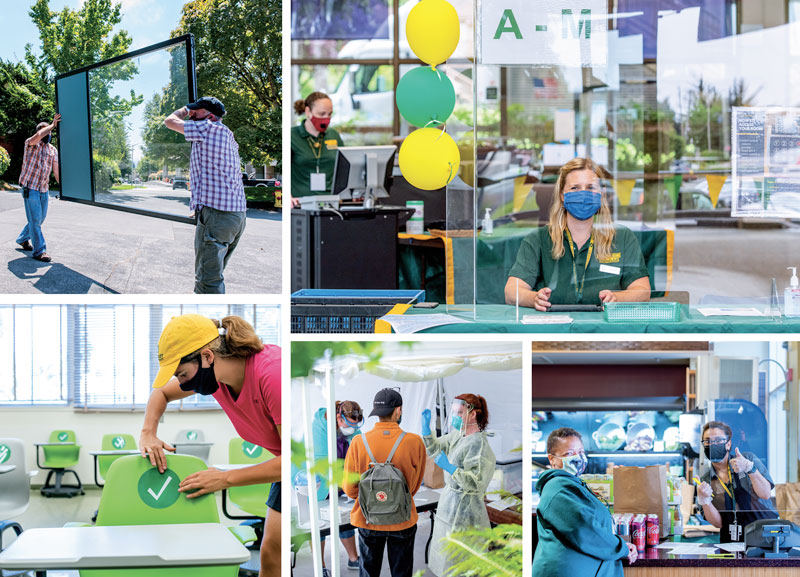
Top Right: Behind their masks, friendly Housing staff welcomes students back to campus on move-in day. Top Left: Across campus, facilities have been modified with safety measures like plexiglass dividers to reduce the spread of COVID-19. Bottom Left: A check marks the spot for each socially distant student. Bottom Middle: Student Health & Wellbeing Services administers COVID-19 tests to students. Bottom Right: Dining staff safely serve students at the College Creek Marketplace.
Putting Health and Wellbeing First
THANKS TO RAPID ADVANCES in medical scientific research, the University was able to start offering COVID-19 vaccinations to the HSU community this Spring. Over the past year, a preventative approach to coronavirus testing has been crucial to the University’s pandemic response.
“The Student Health & Wellbeing Services (SHWS) team has worked tirelessly for our campus and students,” says Sherie Gordon, interim vice president for Administration & Finance.
From March ‘20 to February ‘21, Student Health & Wellbeing Services (SHWS) has performed nearly 6,000 COVID-19 tests with an average positivity rate of 1.29 percent, lower than the rate for county and state populations, as well as
comparable college campuses. Two-thirds of positive student cases have been off-campus residents, suggesting that the safety protocols in the residence halls are a protective factor in virus exposure.
“While testing is critical to minimizing the spread of COVID-19, we also take non-medical measures to keep the HSU community safe,” says Jennifer Sanford, SHWS interim executive director. “Our medical providers also routinely check in on these students to talk about how they are doing physically and emotionally.”
Sanford also emphasizes the key role that Counseling & Psychological Services (CAPS) has played, providing support to the student community through virtual one-on-one and group counseling.
“Our workshops have been really meaningful for students,” says CAPS psychotherapist Ned Peck. “The pandemic has left lots of people feeling isolated and disconnected. Group therapy offers a way to connect.”
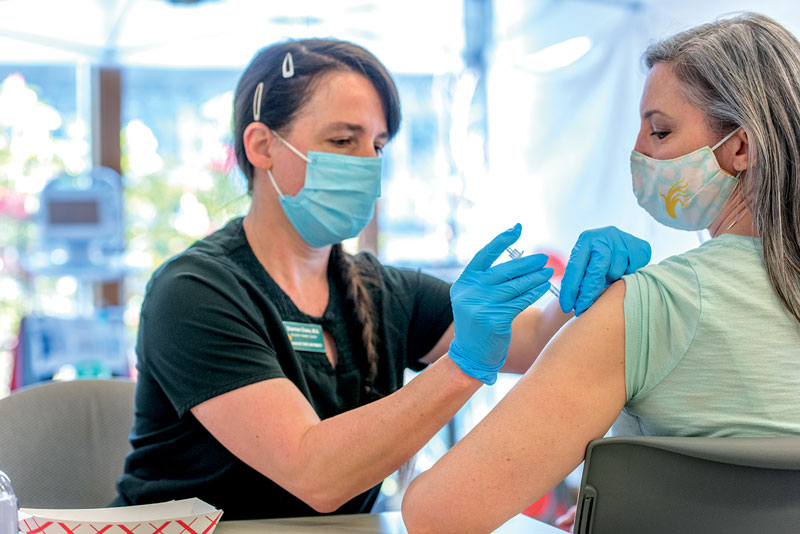
HSU started administering vaccines to the campus community in March 2021.
At Home in Humboldt
As the third semester of the pandemic ticks by, hundreds of students still call campus home. Director of Housing Operations Todd Larsen describes the University’s COVID-19 response as a tight, well-oiled machine. While schools across the country have struggled to control clusters of the virus, HSU’s unified and preventative approach has resulted in good outcomes for the entire community.
All students in the residence halls must take two COVID-19 tests, seven to 10 days apart, after arrival, in addition to quarantining in their rooms for 14 days. The same clearance is required for students enrolled in face-to-face classes and any student who travels outside of the county upon return.
To manage the volume of testing records, Larsen and his team are in constant communication with SHWS and Humboldt County Public Health about testing. Resident Advisors and Housing staff help students navigate the process by sending reminders via email, text, and phone call, and have even walked students to their test appointments.
“It’s critical that we’re all doing our part,” says Larsen. “Our success depends on working together.”
In addition to testing, Housing and SHWS manage a University-wide contact tracing, backed by the County’s Public Health system. To accommodate positive contacts and contacts of positive cases, one residence hall on campus is set up with isolation units, prepped for students to live alone, for 10 to 14 days.
“We know it’s tough,” says Larsen. “The isolation is really challenging, mentally and emotionally.”
To help, Housing offers students in isolation a number of creature comforts, including linens, towels, yoga mats, and coloring books. They also send packing lists in preparation, underscoring comfy clothes and phone chargers.
“Our Resident Advisors do a lot of virtual programming to try and keep some fun in the mix,” says Larsen.
Coming Together in a Crisis
Across the country, students found themselves scrambling to make up for lost wages, secure emergency housing, and handle unexpected costs brought on by the pandemic, particularly around virtual learning.
Since March 2020, donors have rallied for HSU students, giving more than $130,000 to the Student Adversity Fund to cover a wide range of needs, from technology to basic living expenses. HSU has distributed 500 laptops and 400 hotspots to students, along with headsets, webcams, mice, and cables, thanks to support from the HSU Student Adversity Fund along with the Coronavirus Aid, Relief, and Economic Security (CARES) Act, a federal law meant to help cover emergency expenses related to COVID-19.
The University has allocated nearly $10 million in CARES emergency grants to students, plus an additional $50,000 in CARES funds has been dispersed to help HSU students living in rural areas access high-speed internet. Thanks to the generosity of the Humboldt Area Foundation (HAF) and donors, more than $20,000 was raised in support of California Dream Act students, who might not have been eligible for emergency federal CARES funding. HAF provided an additional $20,000 to support healthcare, housing, utilities, food, and other expenses for basic needs.
Environmental Science & Management major Gio Guerrero says this assistance has made all the difference in his senior year.
“HSU helped me to adjust to online learning by supplying me with a laptop,” says Guerrero. “Overall, my professors have been so understanding and helpful.”
Feeding the Lumberjack Family
The pandemic has also intensified food insecurity. Knowing that college students are already at risk for struggling to meet their basic needs, the Dining team and HSU’s Oh SNAP! Student Food Programs redesigned operations last year to keep students nourished.
To prevent virus exposure on campus, Dining works closely with Housing, Facilities, and the EOC to coordinate meal delivery for students in isolation.
“Our number one priority is keeping students fed safely,” says Dining Services Director Melanie Bettenhausen.
Since last Spring, the Dining team has packaged over 145,000 “takeout” meals, which students can pick up from The J or College Creek Marketplace and enjoy with reduced risk of exposure to the virus.
Remarkably, Dining transitioned from a dine-in model to takeout without sacrificing the University’s commitment to sustainability. Serving food in reusable OZZI containers, Dining implemented an honor system that depends on students returning used food containers to 90-gallon cans placed around campus.
“We divert 2,000 containers from the landfill every day of the pandemic,” says Bettenhausen. “It never would have been possible without the hard work of our custodial team.” Back at The J, each container runs through the industrial dishwasher, which is FDA-approved to kill coronavirus.
With additional layers of protection, including masks and the routine sanitization of food-preparation facilities and common touch areas, Dining is working with reduced staff to accommodate physical distance protocols in the workplace. Bettenhausen says it’s been tough, but her team’s dedication has been commendable.
“At the end of the day, we’re here to nourish HSU students, faculty, and staff,” says Bettenhausen.
To ensure that no student goes without, the Oh SNAP! food pantry expanded services last year with pre-packaged meals with vegan, vegetarian, or meat-based options for pick-up. Each student enrolled in Oh SNAP! is eligible to receive one bag a week, supplemented with fresh local produce when available.
“Since last Spring, 90% of the students who use Oh SNAP! are coming in every single week,” explains Oh SNAP! coordinator Ravin Craig.
To accommodate students with transportation issues or medical concerns, the Oh SNAP! team delivers produce and groceries. Last fall, they made about 40 deliveries per week, off and on campus, and even worked with delivery services out of the area for students studying remotely.
To have fun and stay healthy with virtual platforms, Oh SNAP! hosts several cooking classes each semester. Students who sign up can pick up ingredient bags at Oh SNAP! and participate in live Zoom cooking classes at home. “It’s a lot of fun and a great way to learn about healthy seasonal food,” says Craig.
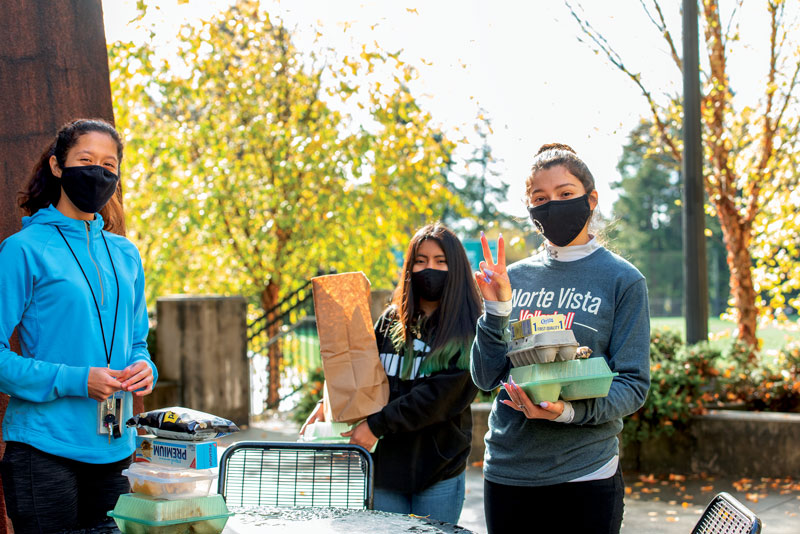
Students pickup Harvest meals prepared by Dining Services over the holidays.